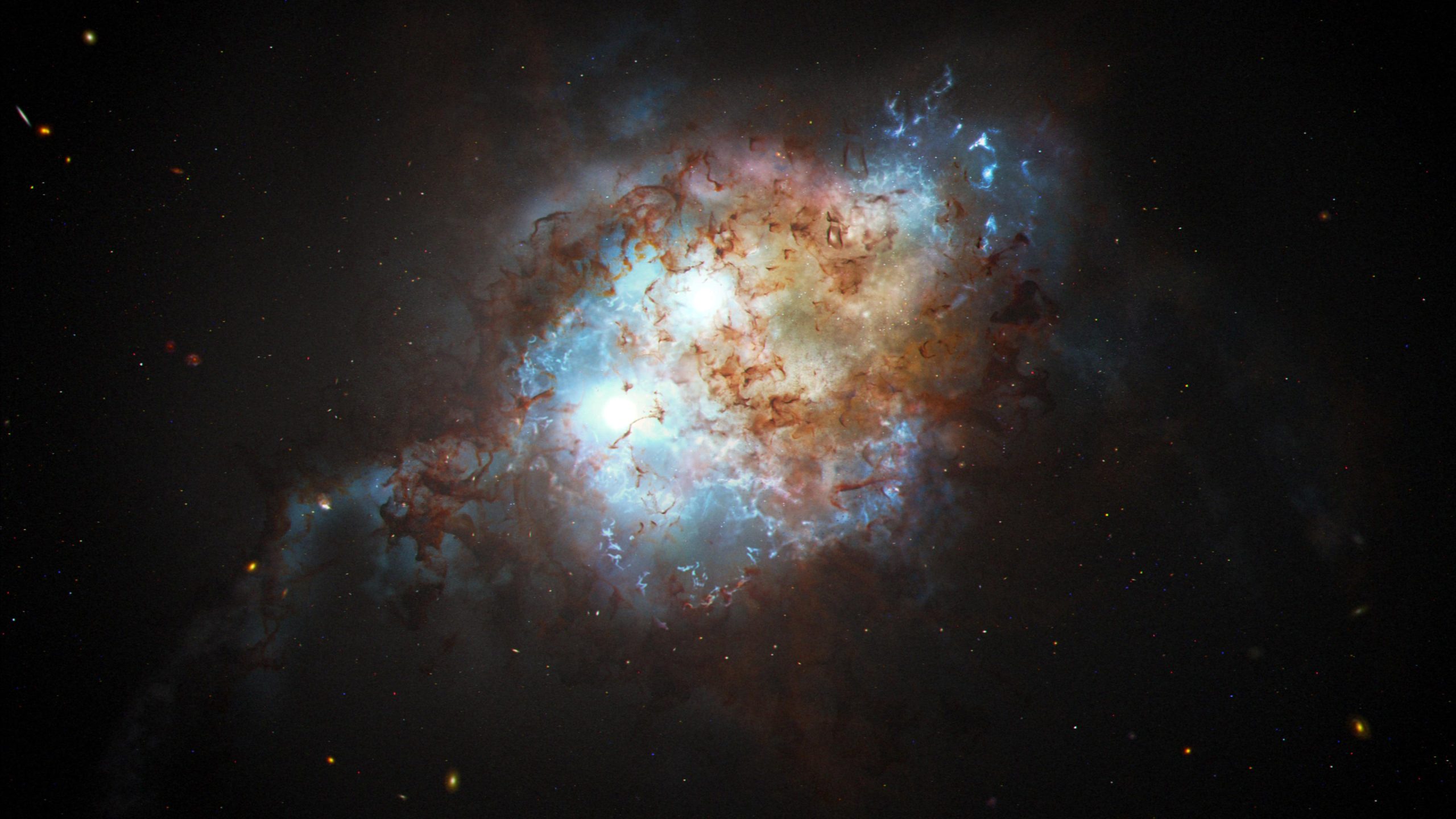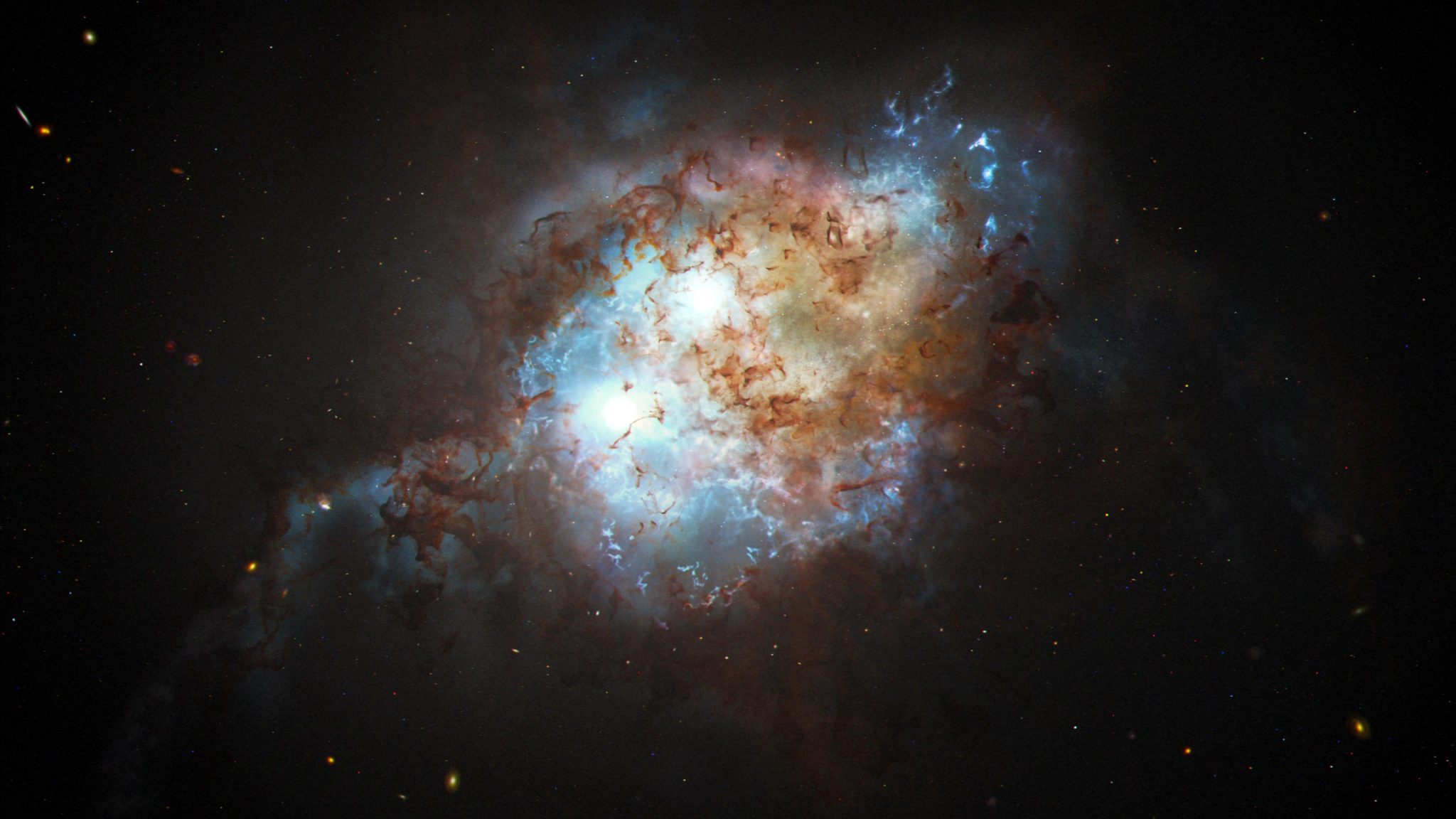

O conceito deste artista mostra o brilho intenso de dois quasares no centro de duas galáxias no caótico processo de fusão. Um cabo de guerra entre as duas galáxias provocou uma tempestade de nascimento de estrelas. Os quasares são faróis brilhantes de luz intensa dos centros de galáxias distantes. Eles são alimentados por buracos negros supermassivos que se alimentam vorazmente de matéria em queda. Esse frenesi estimulante desencadeia uma inundação de radiação que pode ofuscar a luz coletiva de bilhões de estrelas na galáxia hospedeira. Em algumas dezenas de milhões de anos, os buracos negros e suas galáxias, assim como o par de quasares, irão se fundir, formando um buraco negro ainda mais massivo. Crédito: NASA, ESA e Joseph Olmsted (STScI)
Um par de galáxias fundidas inflama buracos negros em rota de colisão
Os quasares estão entre os mais brilhantes do universo. Ele está espalhado pelo céu, brilhando com a riqueza de mais de 100 bilhões de estrelas. E como uma explosão atmosférica brilhante de 4 de julho, eles brilham por um tempo relativamente breve – em escalas de tempo cósmicas. Isso porque eles são alimentados por buracos negros supermassivos que devoram muito gás e poeira que aquecem a altas temperaturas. Mas o bufê de comida do quasar dura pouco.
Essa propriedade fugaz dos quasares ajudou os astrônomos a encontrar dois quasares que estão em rota de colisão um com o outro. Ele está inserido em um par de galáxias que colidiram umas com as outras 10 bilhões de anos atrás. É raro encontrar uma dupla tão dinâmica no universo distante. A descoberta fornece pistas de como o universo era instável há muito tempo, quando as galáxias colidiam com frequência e os buracos negros fervilhavam de detritos e jatos de encontros próximos.
Como os dois quasares piscam em taxas diferentes à medida que o influxo de velas de combustível diminui, eles foram identificados como uma atividade incomum ocorrendo no espaço. O Hubble aumentou o zoom e resolveu claramente a imagem, assim como as galáxias hospedeiras.

Imagem do Telescópio Espacial Hubble de um par de quasares que existiam quando o universo tinha apenas 3 bilhões de anos. Ele está embutido em um par de galáxias em colisão. Os quasares são separados pelo tamanho de menos de uma galáxia. Os quasares são alimentados por ferozes buracos negros supermassivos que irrompem em ferozes fontes de energia enquanto se engasgam com gás, poeira e tudo o mais que estiver ao seu alcance gravitacional. Os buracos negros acabarão por se fundir. Crédito: NASA, ESA, Yu-Ching Chen (UIUC), Hsiang-Chih Huang (IAS), Nadja Zakamska (JHU), Yu Chen (UIUC)
O Telescópio Espacial Hubble inesperadamente encontra um quasar duplo em um universo distante
O universo primitivo era um lugar volátil com galáxias colidindo umas com as outras e até se fundindo. Usar[{” attribute=””>NASA’s Hubble Space Telescope and other space and ground-based observatories, astronomers investigating these developments have made an unexpected and rare discovery: a pair of gravitationally bound quasars, both blazing away inside two merging galaxies. They existed when the universe was just 3 billion years old.
Quasars are bright objects powered by voracious, supermassive black holes blasting out ferocious fountains of energy as they engorge themselves on gas, dust, and anything else within their gravitational grasp.
“We don’t see a lot of double quasars at this early time in the universe. And that’s why this discovery is so exciting,” said graduate student Yu-Ching Chen of the University of Illinois at Urbana-Champaign, lead author of this study.
Finding close binary quasars is a relatively new area of research that has just developed in the past 10 to 15 years. Today’s powerful new observatories have allowed astronomers to identify instances where two quasars are active at the same time and are close enough that they will eventually merge.
There is increasing evidence that large galaxies are built up through mergers. Smaller systems come together to form bigger systems and ever larger structures. During that process there should be pairs of supermassive black holes formed within the merging galaxies. “Knowing about the progenitor population of black holes will eventually tell us about the emergence of supermassive black holes in the early universe, and how frequent those mergers could be,” said Chen.

This compass image shows a Hubble Space Telescope photograph of a pair of quasars that existed when the universe was just 3 billion years old. They are embedded inside a pair of colliding galaxies. The quasars are separated by less than the size of a single galaxy. Quasars are powered by voracious, supermassive black holes blasting out ferocious fountains of energy as they engorge themselves on gas, dust, and anything else within their gravitational grasp. The black holes will eventually merge. Credit: NASA, ESA, Yu-Ching Chen (UIUC), Hsiang-Chih Hwang (IAS), Nadia Zakamska (JHU), Yue Shen (UIUC)
We’re starting to unveil this tip of the iceberg of the early binary quasar population,” said Xin Liu of the University of Illinois at Urbana-Champaign. “This is the uniqueness of this study. It is actually telling us that this population exists, and now we have a method to identify double quasars that are separated by less than the size of a single galaxy.”
This was a needle-in-haystack search that required the combined power of NASA’s Hubble Space Telescope and the W.M. Keck Observatories in Hawaii. Multi-wavelength observations from the International Gemini Observatory in Hawaii, NSF’s Karl G. Jansky Very Large Array in New Mexico, and NASA’s Chandra X-ray Observatory also contributed to understanding the dynamic duo. And, ESA (European Space Agency)’s Gaia space observatory helped identify this double quasar in the first place.
“Hubble’s sensitivity and resolution provided pictures that allow us to rule out other possibilities for what we are seeing,” said Chen. Hubble shows, unequivocally, that this is indeed a genuine pair of supermassive black holes, rather than two images of the same quasar created by a foreground gravitational lens. And, Hubble shows a tidal feature from the merging of two galaxies, where gravity distorts the shape of the galaxies forming two tails of stars.
However, Hubble’s sharp resolution alone isn’t good enough to go looking for these dual light beacons. The researchers enlisted Gaia, which launched in 2013, to pinpoint potential double-quasar candidates. Gaia measures the positions, distances, and motions of nearby celestial objects very precisely. But in a novel technique, it can be used to explore the distant universe. Gaia’s huge database can be used to search for quasars that mimic the apparent motion of nearby stars. The quasars appear as single objects in the Gaia data because they are so close together. However, Gaia can pick up a subtle, unexpected “jiggle” that mimics an apparent change in position of some of the quasars it observes.
In reality, the quasars aren’t moving through space in any measurable way. Instead, their jiggle could be evidence of random fluctuations of light as each member of the quasar pair varies in brightness on timescales of days to months, depending on their black hole’s feeding schedule. This alternating brightness between the quasar pair is similar to seeing a railroad crossing signal from a distance. As the lights on both sides of the stationary signal alternately flash, the sign gives the illusion of “jiggling.”
Another challenge is that because gravity warps space like a funhouse mirror, a foreground galaxy could split the image of a distant quasar into two, creating the illusion it was really a binary pair. The Keck telescope was used to make sure there was no lensing galaxy in between us and the suspected double quasar.
Because Hubble peers into the distant past, this double quasar no longer exists. Over the intervening 10 billion years, their host galaxies have likely settled into a giant elliptical galaxy, like the ones seen in the local universe today. And, the quasars have merged to become a gargantuan, supermassive black hole at its center. The nearby giant elliptical galaxy, M87, has a monstrous black hole weighing 6.5 billion times the mass of our Sun. Perhaps this black hole was grown from one or more galaxy mergers over the past billions of years.
The upcoming NASA Nancy Grace Roman Space Telescope, having the same visual acuity as Hubble, is ideal for binary quasar hunting. Hubble has been used to painstakingly take data for individual targets. But Roman’s very wide-angle infrared view of the universe is 200 times larger than Hubble’s. “A lot of quasars out there could be binary systems. The Roman telescope can do huge improvements in this research area,” said Liu.
The results will be published in the April 5 journal Nature.
Reference: “A close quasar pair in a disk–disk galaxy merger at z = 2.17” by Yu-Ching Chen, Xin Liu, Adi Foord, Yue Shen, Masamune Oguri, Nianyi Chen, Tiziana Di Matteo, Miguel Holgado, Hsiang-Chih Hwang and Nadia Zakamska, 5 April 2023, Nature.
DOI: 10.1038/s41586-023-05766-6
The Hubble Space Telescope is a project of international cooperation between NASA and ESA. NASA’s Goddard Space Flight Center in Greenbelt, Maryland, manages the telescope. The Space Telescope Science Institute (STScI) in Baltimore, Maryland, conducts Hubble and Webb science operations. STScI is operated for NASA by the Association of Universities for Research in Astronomy, in Washington, D.C.

“Maven da Web. Geek de cerveja irritantemente humilde. Fanático por bacon. Criador típico. Especialista em música.”





More Stories
Inspetor Geral da NASA emite relatório contundente sobre atrasos no projeto de lançamento da espaçonave SLS
Como os buracos negros ficaram tão grandes e rápidos? A resposta está no escuro
Uma estudante da Universidade da Carolina do Norte se tornará a mulher mais jovem a cruzar as fronteiras do espaço a bordo da Blue Origin